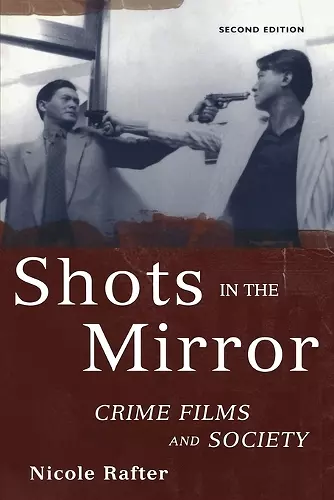Shots in the Mirror
Crime Films and Society
Format:Paperback
Publisher:Oxford University Press Inc
Published:25th May '06
Currently unavailable, and unfortunately no date known when it will be back

Movies play a central role in shaping our understanding of crime and the world generally, helping us define what is good and bad, desirable and unworthy, lawful and illicit, strong and weak. Crime films raise controversial issues about the distribution of social power and the meanings of deviance, and they provide a safe space for fantasies of rebellion, punishment, and the restoration of order. In the first comprehensive study of its kind, well-known criminologist Nicole Rafter examines the relationship between society and crime films from the perspectives of criminal justice, film history and technique, and sociology. Shots in the Mirror begins with an overview of the history of crime films and the emergence of various genres, surveying important films from the silent era, the early gangster films of the '30s, classic film noir, the work of Hitchcock, and recent innovations by Scorsese, Tarrentino, and the Coen brothers. Keeping pace with the evolution of crime films, Shots in the Mirror has been updated to respond to recent developments, trends, and shifting circumstances in the genre. This new edition expands the scope and increases the depth and variety of the previous edition by including foreign films in addition to American movies. Rafter also integrates an entirely new body of literature into the study, reflecting the rapid expansion of scholarship on law-related films over the past three years. She has added a chapter on psycho movies, a previously unrecognized subcategory of crime films. Another new chapter, "The Alternative Tradition and Films of Moral Ambiguity," focuses on recent sex crime films. This new final chapter grows organically out of the first edition's distinction between traditional crime films, with their easy solutions to social problems, and those more unusual critical films which belong to the bleaker, morally ambiguous, alternative tradition. Rafter examines more than three hundred films in this study, considering what they have to say, socially and ideologically, about the causes of crime, and adding valuable contributions to the on-going debate on whether media representations of violence cause crime. Shots in the Mirror is both a marvelous history of crime films and a trenchant analysis of their complex relationship to larger society.
It's hard to imagine a more entertaining, well researched, and insightful encyclopedia of English-language crime films. Anyone who wants to know the history and place of crime cinema in the US should start here. Criminologist Rafter combines formidable analytic skills with a genuine love of the movies. Her well supported arguments help us to see many of them in new ways. Each chapter made me want to run out and look at films she discusses; but I didn't want to set the book down until I had finished it. * Neil King, Virginia Polytechnic Institute and State University *
Shots in the Mirror is a book for scholars as well as for buffs by one who is clearly both. It is also a necessary book for students of crime and society as well as for students of film. In this new edition Rafter goes even more pointedly to the question of how crime movies `mirror' our world, reflecting the blank, the ambiguous and the unfinished, as well as the heroic and the villainous. I expect to use this book in my teaching, but mainly to devour it for my own pleasure and education. * Richard Sparks, The University of Edinburgh *
Praise for the previous edition: "No serious studies have been conducted of how on-screen crime influences our perception of real-world crime. It is an ambitious topic, and [Rafter] handles it well in a very brief volume.... [She] concludes with a very interesting exploration of future social problems and how they may be played out on screen.... Food for thought on a very clever topic. * Library Journal *
Brims with variety * this may be the only film book that cites the protagonist of Falling Down, The Last Seduction, and The Godfather in one sentence.Kirkus Reviews *
Provides a brief survey that manages to range wider than other literature in the canon.... [Rafter's] strategy works well to fill a gap in the literature of 'criminological issues raised by movies.' * Choice *
This book can help sociologists who want to know more about crime stories... A terrific resource book for crime movies as documents... The brief comparative accounts of scenarios and character portrayals provide a kind of cultural map about the language of justice, discourses of fear, and the significance of the criminal-as-other. Let us find ways to use such a fine resource to enliven our courses and research, to find ways to tell the right stories. * Contemporary Sociology *
One of my favorite chapters (chapter 2) is the examination of the way in which criminologists drop discredited theories over time, but movies "recycle them" because they resonate with audience expectations that are measured by box office receipts. * Contemporary Sociology *
ISBN: 9780195175066
Dimensions: 236mm x 156mm x 19mm
Weight: 413g
288 pages
2nd Revised edition